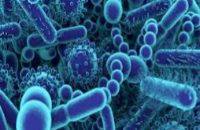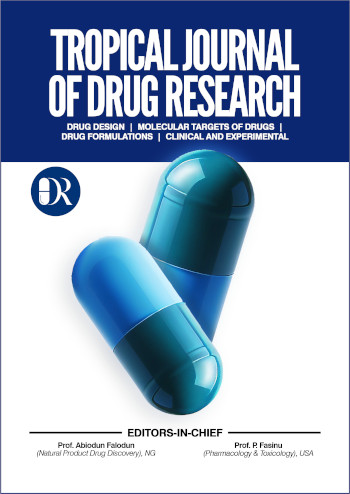Phytochemical analysis and antibacterial activity of acetone extract of Terminalia catappa Linn. leaves
DOI:
https://doi.org/10.26538/tjdr/v2i2.3Keywords:
Antibacterial activity, GC-MS, Phytochemical, Terminalia catappaAbstract
Purpose: Traditional medicine has used the leaves of Terminalia catappa for various health benefits, with established antibacterial, antidiabetic, anti-inflammatory, antioxidant, antiviral, and hepatoprotective characteristics. This study aims to perform a phytochemical analysis and antibacterial assay of the acetone extract from T. catappa leaves.
Methods: The dried leaves were subjected to extraction using 50 % acetone, followed by preliminary phytochemical screening, Gas chromatography-mass spectroscopy (GC-MS) analysis, and antibacterial testing of the extract.
Results: Preliminary phytochemical screening identified the presence of carbohydrates, flavonoids, saponins, alkaloids, glycosides, tannins, phenols, terpenoids, and steroids/triterpenoids. GC-MS analysis showed the presence of epiglobulol and thirteen additional phytochemicals, which have been reported to possess antibacterial activity or potential, with epiglobulol exhibiting the highest concentration among all the identified phytochemicals. The diameters of the inhibition zones ranged from 0 to 15 mm for Staphylococcus aureus, 0 to 12 mm for Streptococcus pneumonia, 0 to 12 mm for Escherichia coli, and 0 to 8 mm for Pseudomonas spp, with greater extract concentrations leading to larger inhibition zones—though these were smaller than the inhibition zone diameters observed for gentamicin, which varied between 24.5 and 27 mm across the four tested organisms.
Conclusion: The acetone extract of T. catappa leaves underwent phytochemical analysis, revealing numerous constituents known to exhibit antibacterial properties.
Downloads
References
Maqsood UR, Abdullah FK, Kamal N. Introduction to natural products analysis. In: Silva AS, Nabavi SV, Saeedi M, Nabavi SM, editors. Recent advances in natural products analysis. Elsevier; 2020. p. 3-15.
Boy H, Rutilla A, Santos K, Ty A, Yu A, Mahboob T, Tangpoong J, Nissapatorn V. Recommended medicinal plants as source of natural products: A review. Digit. Chin. Med. 2018;1:131-142.
Vaou N, Stavropoulou E, Voidarou C, Tsigalou C, Bezirtzoglou E. Towards advances in medicinal plant antimicrobial activity: A review study on challenges and future perspectives. Microorganisms 2021;9(10):2041-2068.
Mwangi WC, Waudo W, Shigwenya ME, Gichuki J. Phytochemical characterization, antimicrobial and antioxidant activities of Terminalia catappa methanol and aqueous extracts. BMC Complement Med Ther 2024;24(1):137-147.
Iheagwam FN, Iheagwam OT, Onuoha MK, Ogunlana OO, Chinedu SN. Terminalia catappa aqueous leaf extract reverses insulin resistance, improves glucose transport and activates PI3K/AKT signalling in high fat/streptozotocin-induced diabetic rats. Sci Rep 2022;12(1):15114-119.
Siddiqi R, Naz S, Saeed G, Sayeed S. Antioxidant activity of the extracts derived from Terminalia catappa. PJSIR 2011;54:93-98.
Gao J, Tang X, Dou H, Fan Y, Zhao X. Xu Q. Hepatoprotective activity of Terminalia catappa L. leaves and its two triterpenoids. J Pharm Pharmacol 2004;56:1449-1455.
Zarredar H, Khamaneh AM, Firouzi Amoodizaj F, Shanaehbandi D, Seyedrezazadeh E, Jadid HS, Asadi M, Zafari V, Khalili Y, Soleimani Z, Ansarin A, Khalili M. Terminalia catappa extract (TCE) reduces proliferation of lung and breast cancer cell by modulating miR-21 and miR-34a expressions. Asian Pac J Cancer Prev 2021;22(4):1157-1163.
Vrushabendra SBM, Ahmed SM, Gopkumar P, Dhanapal R, Chandrashekar VM, Rao TS. Antidiarrhoeal activity of Terminalia catappa Linn. leaf extracts in rats. Asian J Chem 2006;18:1236-1242.
Adigwe OP, Ibrahim JA, Gegele IB, Adzu B, Isimi CY. Medicinal plants used for management of asthma in FCT, Abuja and its environs. European J Med Plants 2022;33(1):8-38
Tabansi D, Dahiru D, Patrick AT, Jahng WJ. Anti-atherosclerosis and anti-hyperlipidemia functions of Terminalia catappa fruit. ACS Omega 2023;8(39):35571-35579
Fan YM, Xu LZ, Gao J, Wang Y, Tang XH, Zhao XN, Zhang ZX. Phytochemical and antiinflammatory studies on Terminalia catappa. Fitoterapia 2004;75(3-4):253-260.
Chole P, Ravi L. A review of medicinal potential of Terminalia catappa. Int J Green Pharm 2020;14(3):229-234.
Anand VA, Natarajan D, Pannerselvam PK. An updated review of Terminalia catappa. Pharmacogn Rev 2015;9(18):94-96.
Uddin TM, Chakraborty AJ, Khusro A, Zidan RM, Mitra S, Emran T, Dhama K, Ripon KH, Gajdacs M, Saihibzada MUK, Hossain J, Koirala N. Antibiotic resistance in microbes: History, mechanisms, therapeutic strategies and future. J Infect Public Health 2021;14(12):1750-1766.
Manzur A, Raju A, Rahman S. Antimicrobial activity of Terminalia catappa extracts against some pathogenic microbial strains. Pharmacol Pharm 2011;2:299-305.
Chanda S, Rakholiya K, Nair R. Antimicrobial activity of Terminalia catappa L. leaf extracts against some clinically important pathogenic microbial strains. Chin Med 2011;2:171-177.
Sowmya T, Raveesha, K. Antibacterial activity and time-kill assay of Terminalia catappa L. and Nigella sativa L. against selected human pathogenic bacteria. J Pure Appl Microbiol 2021;15(1):285-299.
Ngo TV, Scarlett CJ, Bowyer MC, Ngo PD, Vuong QV. Impact of different extraction solvents on bioactive compounds and antioxidant capacity from the root of Salacia chinensis L. J Food Qual 2017;9305047:1-8.
Trease GE, Evans WC. Trease and Evans pharmacognosy. 14th ed. London: W.B. Saunders Company Limited; 2009. p. 191-293.
Kumari S, Ichhpujani RL. Guidelines on standard operating procedures for microbiology. Geneva: WHO; 2000. p. 1-65.
Quy DD, Angkawijaya EA, Tran-Nguyen PL, Huynh LH, Soetaredjo FE, Ismadji S, Ju Y-H. Effect of extraction solvent on total phenol content, total flavonoid content, and antioxidant activity of Limnophila aromatica. J Food Drug Anal 2014;22(3):296-302.
Memi GG, Onubiyi JA, Tyohemba ST, Ndukwe NN. Phenolic and flavonoid contents, and scavenging activity of Terminalia catappa leaves extracts. Niger Res J Chem Sci 2020;8(1):71-81.
Zhang QW, Lin LG, Ye WC. Techniques for extraction and isolation of natural products: A comprehensive review. Chin Med 2018;13(20):1-26.
Karou D, Dicko MH, Simpore J, Traore AS. Antioxidant and antibacterial activities of polyphenols from ethnomedicinal plants of Burkina Faso. Afr J Biotechnol 2005;4:823-828.
Devi GK, Manivannan K, Thirumaran G, Rajathi FA, Anantharaman P. In vitro antioxidant activities of selected seaweeds from the southeast coast of India. Asian Pac J Trop Med 2011;4:205-211.
Amako NF, Mgbemena MN, Odo SP. GC-MS profile and antimicrobial activities of extracts from root of Senna occidentalis Linn. Ovidius Univ. Ann Chem 2023;34(2):63-71.
Das SK, Dash S, Thatoi H, Patra JK. In vitro α-amylase and α-glucosidase inhibition, antioxidant, anti-inflammatory activity, and GC-MS profiling of Avicennia alba Blume. Comb Chem High Throughput Screen 2020;23(9):945-954.
Sivakumar SR. GC-MS analysis and antibacterial potential of white crystalline solid from red algae Portieria hornemannii against the plant pathogenic bacteria Xanthomonas axonopodis pv. citri and Xanthomonas campestris pv. malvacearum. Int J Adv Res 2014;2(3):174-183.
Huang L, Zhu X, Zhou S, Cheng Z, Shi K, Zhang C, Shao H. Phthalic acid esters: Natural sources and biological activities. Toxins (Basel) 2021;13(7):495-512.
Gurram SR, Azam MA. Design, synthesis and biological evaluation of some novel N-(1,3-benzothiazol-2-yl)-arylamide derivatives as antibacterial agents. Chem Pap 2021;75:5435-5452.
Akbar M, Amin A, Khalil T, Iqbal MS, Nazir A, Taswar A. Antibacterial activity of Alternanthera philoxeroides (Mart.) Griseb. against bacterial phytopathogens: Erwinia carotovora, Ralstonia solanacearum and Xanthomonas axonopodis. Allelopathy J 2021;53(1):83-92.
Jabra-Rizk MA, Meiller TF, James CE, Shirtliff ME. Effect of farnesol on Staphylococcus aureus biofilm formation and antimicrobial susceptibility. Antimicrob Agents Chemother 2006;50(4):1463-1469.
More K, Tayade S, Gawande P, Manik S, Shelke D. Antioxidant and antimicrobial potential of Canavalia gladiata (Jacq.) DC. leaves and seeds: GC-MS-based metabolic profiling. Indian J Nat Prod Resour 2022;13(2):163-169.
Zheng CJ, Yoo JS, Lee TG, Cho HY, Kim YH, Kim WG. Fatty acid synthesis is a target for antibacterial activity of unsaturated fatty acids. FEBS Lett 2005;579(23):5157-5162.
Ramalakshmi N, Amuthalakshmi S, Yamuna R, Anton Smith A, Arunkumar S. Indolizine: A privileged biological scaffold. Der PharmaChemica 2021;13(2):60-69.
Kashyap P, Verma S, Gupta P, Narang R, Lal S, Devgun M. Recent insights into the antibacterial potential of benzothiazole derivatives. Med Chem Res 2023;29:1-31.
Arora G, Sharma S, Sahni T, Sharma P. Antioxidant and antimicrobial activity of some 2-phenyl-1H-indoles and benzimidazoles. Indian J Pharm Sci 2018;80(4):739-744.
Naik HRP, Naik HSB, Naik R, Naika H, Kuluvar G, Mahmood R, Ahamed BMK. Synthesis of novel benzo[h]quinolines: Wound healing, antibacterial, DNA binding, and in vitro antioxidant activity. Eur J Med Chem 2008;44:981-989.
Kalariya R, Pandya V, Gohil N, Bhattacharjee G, Singh V, Rajani DP, Bhosale R, Yadav JS. Synthesis, biological evaluation, and molecular docking study of novel amide-coupled naphthalene scaffolds as potent inhibitors of bacterial recombinase A. Eur J Med Chem Rep 2022;6:100078:1-13.
Iheagwam FN, Israel EN, Kayode KO, De Campos OC, Ogunlana OO, Chinedu SN. GC-MS analysis and inhibitory evaluation of Terminalia catappa leaf extracts on major enzymes linked to diabetes. Evid Based Complement Alternat Med 2019;6316231:1-14.
Saharan A, Dhiman A, Dureja H. Phytochemical analysis of Terminalia catappa Linn fruit in ethanolic extract using GC-MS. Int. J. Pharm. Pharm. Res 2019;16(1):336-349.
Punniyakotti P, Anand AV. GC-MS and in silico analysis of phytoconstituents from the ethanolic extract of Terminalia catappa leaves and Terminalia chebula fruits. Res J Life Sci Bioinform Pharm Chem Sci 2018;4(6):740-748.
Davis WW, Stout TR. Disc plate methods of microbiological antibiotic assay. Appl Microbiol 1971;22(4):659-665.
Altemimi A, Lakhssassi N, Baharlouei A, Watson DG, Lightfoot DA. Phytochemicals: Extraction, isolation, and identification of bioactive compounds from plant extracts. Plants (Basel) 2017;6(4):42-64.
Kokora PA, Ackah JAB, Nanga ZY, Kra MAK, Loukou GY, Coulibaly A, Djaman J. Antibacterial activity of ethanolic and aqueous extracts of four medicinal plants on the in vitro growth of Escherichia coli and Staphylococcus aureus. J Drug Deliv Ther 2013;3(3):113-116.
Janesha UGS, Rathnayako H, Hewasom RP, Wijayatne MDGB. In vitro evaluation of the antimicrobial activity of Listea iteodaphne against a selected group of bacteria, including methicillin-resistant Staphylococcus aureus. Adv Biomed Res 2020;9:21-27.
Pang Z, Raudonis R, Glick BR, Lin T-J, Cheng Z. Antibiotic resistance in Pseudomonas aeruginosa: mechanism and alternative therapeutic strategies. Biotechnol Adv 2019;37(1):177-192.

Published
Issue
Section
License

This work is licensed under a Creative Commons Attribution-NonCommercial-ShareAlike 4.0 International License.




